 Trophic ulcer of the leg is a deep and inflamed wound on the skin of the leg that does not heal for more than 6 weeks, which occurs due to insufficient outflow of blood from this area of the skin and due to malnutrition of the cells.
Trophic ulcer of the leg is a deep and inflamed wound on the skin of the leg that does not heal for more than 6 weeks, which occurs due to insufficient outflow of blood from this area of the skin and due to malnutrition of the cells.
This disease is not independent, it arises as a complication after a number of diseases, 70% of which are somehow connected with veins. The development of trophic ulcers leads to tissue loss, to a decrease in the protective and protective functions of the body. After healing, scars remain on the skin.
The disease is in the field of studying phlebology - a branch of medicine that studies veins, diagnoses, treats and prevents diseases associated with them.
Contents
- Meet the ulcer!
- Stages of development of pathology
- Causes of occurrence of
- How does it arise?
- Features of the clinical picture
- Complex of therapeutic measures
- Features of nutrition
- Complex of conservative measures
- Local treatment
- Surgical intervention
- Other methods of treatment
- Prevention of trouble
- Complications and danger
- Important to know
Meet the ulcer!
Judging by unofficial statistics, every fifth person( most often a woman), who has varicosity( varicose veins) in her arsenal, suffers from a complication - a trophic ulcer. 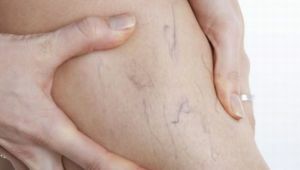
Varicose veins are a constant and often irreversible widening or lengthening of the veins( ie vessels carrying blood to the heart) of the lower limbs, which is accompanied by thinning of the venous wall and the formation of "nodes".
An ulcer occurs if the patient's disease progresses for a long time or if in addition there is thrombophlebitis.
The following symptoms appear: the skin on the site of the ulcer thickens, reddens and swells, and pigmentation may occur( appearance of light and dark spots in comparison with the usual skin color).Then there is an ulcer, which greatly worsens the patient's condition.
Stages of development of pathology
There are 3 stages of the development of the disease:
- Exudation. The most unpleasant stage for both the patient and the doctor. It is accompanied by inflammation along the perimeter of
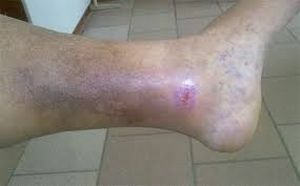 of damaged skin( i.e., perifocal), foci of tissue necrosis, contamination by various microorganisms and secretions with an unpleasant purulent smell. It happens that at the same time inflamed lymphatic vessels: there is lymphangitis, eczema, thrombophlebitis and erysipelatous inflammation. If the infection worsens, obliteration occurs( infection of the lumens of the vessels) and a violation of the outflow of fluid through the lymphatic vessels, which leads to lymphedema( a pathological condition accompanied by an increasing swelling of the soft tissues of the affected area).
of damaged skin( i.e., perifocal), foci of tissue necrosis, contamination by various microorganisms and secretions with an unpleasant purulent smell. It happens that at the same time inflamed lymphatic vessels: there is lymphangitis, eczema, thrombophlebitis and erysipelatous inflammation. If the infection worsens, obliteration occurs( infection of the lumens of the vessels) and a violation of the outflow of fluid through the lymphatic vessels, which leads to lymphedema( a pathological condition accompanied by an increasing swelling of the soft tissues of the affected area). - Reparation. In this phase, the ulcer is gradually released from the necrotic tissues, its granulation begins( the wound is infected with new tissues).The area of perifocal inflammation decreases, the number of secretions decreases.
- Epithelialization. The beginning of this stage is the formation of a strip of fresh tissue along the perimeter of the wound. Its surface at that time is clean, new granulations. Allocations are meager, only serous( clear liquid).
Causes of
As mentioned earlier, trophic ulcer of the leg is not an independent disease. It arises as a complication in the following diseases:
- varicose veins( varicose veins);
- thrombophlebitis;
- hypertension;
- atherosclerosis;
- diabetes;
- of lymphedema;
- Eczema;
- systemic vasculitis.
How does it come about?
Because of the above cases, the venous circulation is disturbed in the lower limbs, and through time the blood stagnates, gradually accumulating the products of the vital activity of the cells.
Tissue nutrition worsens, and the skin thickens, soldering with subcutaneous tissue. Then eczema arises: dry and wet. And behind it are all the other symptoms.
Features of the clinical picture
The trophic ulcer should be recognized as quickly as possible, otherwise severe complications can occur until the heart cells degenerate into malignant ones.
These are the sensations in the shin area most often experienced by the patient: 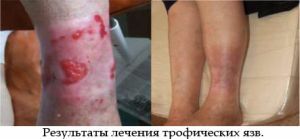
- itching and burning;
- skin coarsening;
- heaviness;
- swelling;
- pain.
Externally, the disease manifests itself:
- in the form of a network of cyanotic vessels on the lower leg;
- in the appearance of pigmented spots of purple and magenta flowers, which then merge into one hyperpigmentation zone;
- in the acquisition of a glossy skin.
But do not make a diagnosis yourself. To confirm or disprove the initial assumptions, it is necessary to perform at least a few laboratory examinations, in addition to examining the wound, among which:
- blood test;
- blood test from a wound;
- urine analysis;
- immunological studies;
- US of vessels;
- angiography of vessels.
Complex of therapeutic measures
After the diagnosis is confirmed, the specialist appoints a set of measures necessary to treat the patient. To avoid complications and cure an ulcer, the patient must strictly follow all the prescriptions.
Features of nutrition
First, a doctor is prescribed a diet. There will be foods that inhibit the development of atherosclerosis and changes in blood vessels. It excludes fatty, spicy, salty foods and alcohol.
Complex of conservative measures
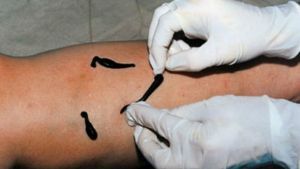 The next stage is conservative treatment of trophic ulcers of the shin.
The next stage is conservative treatment of trophic ulcers of the shin.
It is aimed at general cleansing of the body and ulcers in particular, includes medical therapy and is conducted in special clinics.
The main task is to cure an ulcer without the intervention of a surgeon.
Complex of measures:
- topical treatment of - application of ointments and dressings;
- physiotherapy - special physiotherapy exercises, gymnastics;
- compression therapy - wearing compression linen, which helps inhibit the recurrence of ulcers and improves blood flow;
- electrostimulation - stimulation of circulation of substances in tissues by current;
- hirudotherapy - treatment with leeches, aimed at dissolving blood clots, cleaning the wound and improving blood circulation.
Local treatment
If necessary, you can carry out local treatment, which also contributes to recovery. It is appropriate to conduct phytotherapy( use appropriate decoctions and medicinal herbs) and apply to the wound compresses from sea buckthorn and St. John's wort oil, from chestnut, chamomile, fresh carrots.
Surgical intervention
Surgery is an extreme treatment that is prescribed if nothing else has helped or if the ulcer takes up too much area on the shin.
You can also perform an operation to transplant the damaged skin area( plastic surgery), which literally the next day will relieve the pain.
Other treatments for
The following therapies are also used: 
- Ozone therapy. Ozone is an excellent oxidizer, so with the help of ozonotherapy you can achieve a thorough cleansing of the wound for performing plastic operations. The course consists of 5-10 procedures and is combined with any kind of treatment.
- Argosulfan. This is an antibacterial cream that looks like a white homogeneous mass. Its use promotes faster healing of wounds. Argosulfan is used both in the treatment of ulcers, and in the preparation for plastic surgery. Used by the open method and for bandages.
These are proven and proven methods.
Prevention of trouble
Prevention of trophic ulcers is mainly due to the thorough treatment of diseases that cause ulcers. Complex treatment usually helps to avoid this complication.
Do not forget about diet, gymnastics and compression underwear. Let's rest your legs when you have visible symptoms and use special ointments. Handle any, even the smallest wound. And do not forget about hygiene.
Complications and danger
If you do not take measures to treat a violation, which in itself is a very unpleasant complication, you can have even more serious consequences. Among them:
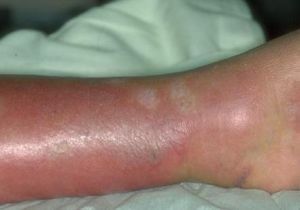
erysipelas
- lymphangitis - acute inflammation of the lymphatic vessels;
- inguinal lymphadenitis - acute inflammation of the lymph nodes in the groin area;
- erysipelatous inflammation is an infectious disease that externally manifests itself as a progressive lesion of the skin;
- degeneration of cells from the lesion into malignant is the most dangerous complication, which can not be reversed: the ulcer begins to develop inside the tissues, while affecting the muscles, tendons and even bones, which can lead to limb amputation.
Important to know
Remember - the complete healing of the trophic ulcer of the shin can not be a guarantee that she will never bother you again. Even if all the provoking diseases are cured, there should be no certainty.
It is recommended that all the prescriptions of the attending physician should be followed, often undergo examinations and do not forget about prevention, then the probability of seeing the disfigured skin of the shin again is minimized.
